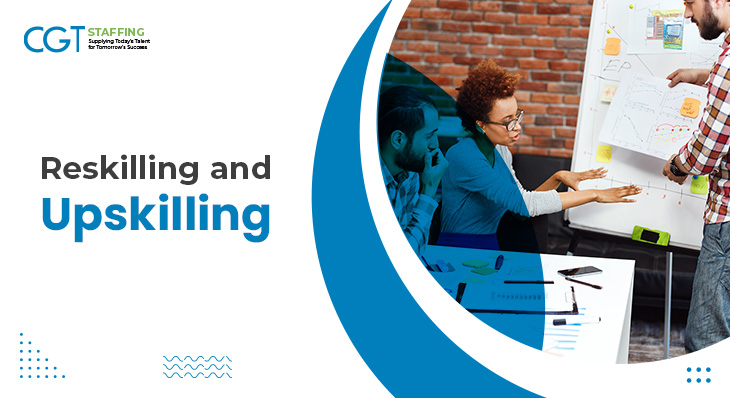In today’s fast-paced, ever-changing world, one thing is certain: change is the only constant. Technology continues to evolve, economies shift, and unexpected events (like pandemics) can throw everything into disarray. All these factors affect the skills in demand in the job market. For both individuals and organizations, staying relevant and effective requires adaptation. That’s where reskilling and upskilling come in – they’re a path to bridging the gap between the skills you have today and the ones you’ll need tomorrow. This blog explores why reskilling and upskilling are crucial to a successful career path.
Table of Contents
Why Reskilling and Upskilling Matter
Over the last few decades, the workplace has undergone enormous changes. Traditional job classifications and career trajectories have grown more variable. Not only are automation, artificial intelligence, and other disruptive technologies superseding previously dominant industries and skill sets, they are also driving expansion of a multitude of new businesses and job categories. To compete in this fast-paced environment, you must be agile and proactive in your skill development, making sure to reskill and upskill. From an organization’s perspective, it translates to reduced productivity and competitive capability. Reskilling and upskilling become your best allies in bridging this gap.
The Benefits of Reskilling and Upskilling
Here are some of the benefits they offer to individuals:
1. Unlocking Career Opportunities
Reskilling and upskilling open doors to new horizons and career advancement. When you add new skills or polish existing ones, you become a more valuable asset to your employer and a more attractive prospect to potential ones.
2. Fortifying Job Security
In a job market that’s constantly changing, job security is a genuine concern. By keeping up with the latest skills and industry trends, you can bolster your job security, making yourself less susceptible to automation and economic downturns.
3. Boosting Earning Potential
Skills that are in demand often command significantly higher earning potential. When you invest in your education and skill development, you command higher salaries and ensure your own improved financial stability.
Benefits for Organizations
Here are some of the ways in which they benefit organizations:
1. Enhanced Productivity
A skilled workforce is a productive workforce. When employees possess the skills that they need to excel in their roles, tasks are completed more efficiently, leading to better overall productivity for the organization.
2. Competitive Edge
Innovation and adaptability are the keys to staying competitive. Organizations that invest in reskilling and upskilling their employees position themselves as innovators, ready to respond to market changes effectively, gaining an edge over competitors.
3. Employee Retention
Employees onboarded through direct hire recruiting value opportunities for growth and development. Providing avenues for reskilling and upskilling not only attracts top talent but also improves employee retention. This saves organizations the costs associated with high turnover.
How to Make Reskilling and Upskilling Work for You
Here are a few tips that might help you gauge where upskilling or reskilling is required:
1. Spot Skill Gaps
Start by identifying the skill gaps within your own skillset or your organization. On top of creating suitable talent acquisition and recruitment strategies, conduct assessments and surveys to pinpoint the skills that are in demand or currently lacking.
2. Foster a Culture of Learning
Cultivate an environment where continuous learning is encouraged. Take charge of your skill development and provide yourself with the resources and support you need. Consider recognizing and rewarding those who actively engage in learning.
3. Offer Diverse Learning Experiences
Everyone learns differently. Ensure that you have access to various learning opportunities. These might include online courses, workshops, mentorship programs, or on-the-job training. Tailor these opportunities to suit your individual preferences and needs.
4. Leverage Technology
Make the most of technology to make learning more accessible and efficient. E-learning platforms, virtual reality simulations, and personalized learning experiences driven by artificial intelligence can greatly enhance the effectiveness of your reskilling and upskilling efforts.
5. Measure Progress
Set key performance indicators (KPIs) to gauge the effectiveness of your reskilling and upskilling initiatives. Regularly evaluate your progress, ensuring that you’re on track to meet your goals, and be ready to adjust your strategy as necessary.
6. Collaborate with Educational Institutions
Explore partnerships with educational institutions to access specialized training and expertise. These collaborations can take the form of internships, apprenticeships, or tailored programs that meet your specific needs.
7. Embrace a Growth Mindset
Encourage a mindset that thrives on growth within your organization. Be open to challenges and view failures as steppingstones to learning and growth. Expose yourself to both centralized and decentralized recruitment initiatives for more holistic feedback and added experience. A positive attitude toward skill development is vital for long-term success.
Conclusion
In a world where change is the only constant and skill demands are continually evolving, reskilling and upskilling aren’t just options; they’re vital. Especially in the case of IT staffing, it is important to constantly polish your skill sets in order to stay relevant. Your investment in your own learning and your commitment to developing your workforce are keys to thriving in an uncertain world. The benefits are crystal clear: brighter career prospects, bolstered job security, heightened productivity, and a competitive edge in your field.
Reskilling and upskilling are journeys, not destinations. They necessitate commitment, resources, and a strong desire to learn and improve. However, the benefits of this investment are well worth the work for both you and your firm. Accept the challenge of adjusting to a shifting skill environment, and you’ll find yourself not just surviving, but thriving in today’s fast-paced workplace.
